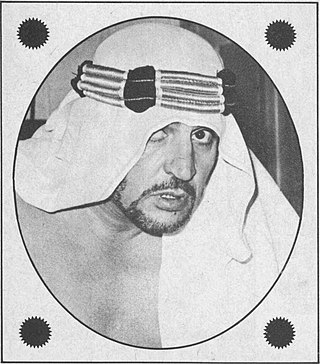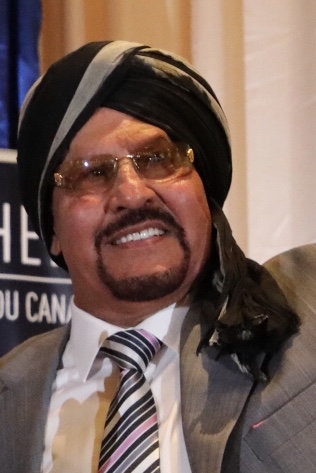Related Research Articles

Michael Lee Alfonso was an American professional wrestler. He was best known for his appearances with the American professional wrestling promotions Extreme Championship Wrestling (ECW), World Championship Wrestling (WCW) and the World Wrestling Federation/Entertainment (WWF/E) under the ring name Mike Awesome and for his appearances in Japan with Frontier Martial-Arts Wrestling and All Japan Pro Wrestling as The Gladiator.

Edward George Farhat was an American professional wrestler, better known by his ring name The Sheik. In wrestling, Farhat is credited as one of the originators of the hardcore style. In addition to his in-ring career, he was also the promoter of Big Time Wrestling, which promoted shows at Cobo Hall in Detroit until the 1980s, and was the booker for Frank Tunney's shows at Maple Leaf Gardens in Toronto from 1971 to 1977.
Michael Allan Bollea is an American retired professional wrestler. The nephew of fellow wrestler Hulk Hogan, he is best known for his appearances with World Championship Wrestling in the late 1990s under the ring name Horace Hogan.
Hiroaki Hamada, better known by his ring name Gran Hamada, is a Japanese professional wrestler, the first to adopt the high-flying Mexican lucha libre style. He has wrestled for New Japan Pro-Wrestling, the Universal Wrestling Federation, Michinoku Pro and All Japan Pro Wrestling and was the founder of Universal Lucha Libre. He has also had stints with the World Wrestling Federation and Extreme Championship Wrestling in the United States. His daughters Xóchitl Hamada and Ayako Hamada are professional Japanese-Mexican wrestlers.

Barney William Irwin is an American retired professional wrestler, better known by his ring name, "Wild" Bill Irwin. Irwin is also known for his appearances with the World Wrestling Federation as The Goon in 1996 to 1997. He is the brother of the late Scott Irwin.

John Mortl Lanzo was an American professional wrestler, better known by his ring name, Blackjack Lanza. Along with his long-term tag team partner, Blackjack Mulligan, Lanza was one-half of The Blackjacks: "black cowboy hat-wearing, cowboy boot-stomping, rugged hombres who drew money wherever they went".

Mark Lewin is an American retired professional wrestler.

Herbert Alan Gerwig was an American professional wrestler, better known by his ring name, Killer Karl Kox. Kox competed in the National Wrestling Alliance as well as international promotions such as All Japan Pro Wrestling, the International Wrestling Alliance and World Championship Wrestling during the 1960s and 1970s.

Jagjeet Singh Hans is an Indo-Canadian retired professional wrestler, known better by his ring name Tiger Jeet Singh. He was known for his elaborate ring entrances, and generally performed as a heel. He wrestled in Japan and was the first professional wrestler in Japan to defeat sumo wrestler Wajima Hiroshi. He held Frontier Martial-Arts Wrestling's World Martial Arts Heavyweight Championship and headlined the company's flagship event Anniversary Show in 1992.

Atsushi Onita is a Japanese actor, politician, and semi-retired professional wrestler. He is best known for his work in Frontier Martial-Arts Wrestling (FMW) and is credited with introducing the deathmatch style of professional wrestling to Japan. He is a former All Asia Tag Team Champions alongside Yoshitatsu.

Michael DiBiase was an American professional wrestler also known by his ring name "Iron" Mike DiBiase. The adoptive father of professional wrestler "The Million Dollar Man" Ted DiBiase, he was married to Ted's mother Helen Hild, and was the grandfather of Mike, Ted Jr., and Brett DiBiase.
The FMW Brass Knuckles Tag Team Championship was a tag team hardcore wrestling championship contested in Frontier Martial-Arts Wrestling.

Michael Davis, best known by the ring names Bugsy McGraw and The Skull, is an American retired professional wrestler. McGraw is known for his long beard and for his philosophical, crazed rants during wrestling interviews. He was a major star in significant territories during the 1970s and 1980s, including major runs in Vancouver, Australia, Florida, Dallas and Memphis.

Hiroshi Ueda was a Japanese professional wrestler, better known by his ring name Umanosuke Ueda. During his wrestling career, Ueda primarily stood out for wrestling with bleached blonde hair, a practice which was rare in his day but later became more common. His ring name was inspired by samurai warrior and Shinsengumi member Umanosuke Ueda.

The NWF Heavyweight Championship was a professional wrestling world heavyweight championship used as part of the National Wrestling Federation and later New Japan Pro-Wrestling.
The Buffalo Athletic Club version of the NWA World Tag Team Championship was a regional professional wrestling championship for tag teams that existed from 1956 until 1970. The championship was promoted by National Wrestling Alliance (NWA) member the Buffalo Athletic Club under promoters Ed Don George and Bobby Bruins, whose territory covered most of northeast Ohio and portions of Western New York. Many NWA territories used a version of the NWA World Tag Team Championship as the NWA bylaws allowed each territory to use the name. In 1957 no less than 13 different NWA World Tag Team Championships were promoted across the United States.[Championships] In 1970 the Buffalo Athletic Club left the NWA to form an independent wrestling promotion known as the National Wrestling Federation, at which point they replaced the NWA World Tag Team Championship with the NWF World Tag Team Championship. Like all professional wrestling championships, this version of the NWA World Tag Team Championship was not won or lost competitively but instead determined by the decision of the bookers of a wrestling promotion. The title was awarded after the chosen team "won" a match to maintain the illusion that professional wrestling is a competitive sport.
The Indianapolis version of the NWA World Tag Team Championship, which was actively used between 1951 and 1960, was a professional wrestling championship exclusively for two-man tag teams. As a member of the National Wrestling Alliance (NWA), the NWA Indianapolis territory was entitled to create an NWA World Tag Team Championship that they could promote within the boundaries of their territory, in this case Indiana, making it a "regional" championship despite being labeled a "world championship". Because the use of the championship was not restricted to one overall championship, a large number of different, regional championships bore the name "NWA World Tag Team Championship" between 1949 and 1992. In 1957 as many as 13 different versions were promoted across the United States.[Championships] As it is a professional wrestling championship, it is not won or lost competitively but instead by the decision of the bookers of a wrestling promotion. The title is awarded after the chosen team "wins" a match to maintain the illusion that professional wrestling is a competitive sport.
The Salt Lake Wrestling Club version of the NWA World Tag Team Championship was a professional wrestling championship for tag teams that was promoted between 1955 and 1959 in the Salt Lake Wrestling Club territory of the National Wrestling Alliance (NWA). Local promoter Dave Reynolds promoted the championship primarily in Utah, but would occasionally runs shows in Idaho and Washington state. Since the promotion was a member of the NWA, the Salt Lake Wrestling Club was entitled to promote their local version of the championship, as the NWA bylaws did not restrict the use of that championship in the same way they restricted the NWA World Heavyweight Championship to one nationally recognized championship. In 1957 there were no less than 13 distinct versions of the NWA World Tag Team Championship promoted across the United States.[Championships] Because the championship was a professional wrestling championship, it was not contested for in legitimate sporting events, but instead determined by the decision of the bookers of a wrestling promotion.

FMW 3rd Anniversary Show: Fall Spectacular (1992) was a professional wrestling event produced by Frontier Martial-Arts Wrestling (FMW). The event took place on September 19, 1992 at the Yokohama Arena in Yokohama, Japan. This was the third edition of the company's flagship event Anniversary Show, commemorating the third anniversary of the company.
1944 in professional wrestling describes the year's events in the world of professional wrestling.
References
- 1 2 3 4 5 6 7 Royal Duncan & Gary Will (2000). "Japan: WWA Brass Knuckles Heavyweight Title". Wrestling Title Histories. Archeus Communications. ISBN 0-9698161-5-4.
- 1 2 3 4 5 6 7 8 9 10 11 12 13 14 15 16 17 18 19 20 21 22 Royal Duncan & Gary Will (2000). "Japan: FMW Brass Knuckles Title". Wrestling Title Histories. Archeus Communications. ISBN 0-9698161-5-4.
- 1 2 3 4 5 6 7 8 9 10 11 Royal Duncan & Gary Will (2000). "Japan: WWA Martial Arts Heavyweight Title". Wrestling Title Histories. Archeus Communications. ISBN 0-9698161-5-4.
- ↑ Hoops, Brian (January 15, 2019). "Pro wrestling history (01/15): Big John Studd wins 1989 Royal Rumble". Wrestling Observer Figure Four Online . Retrieved January 18, 2019.